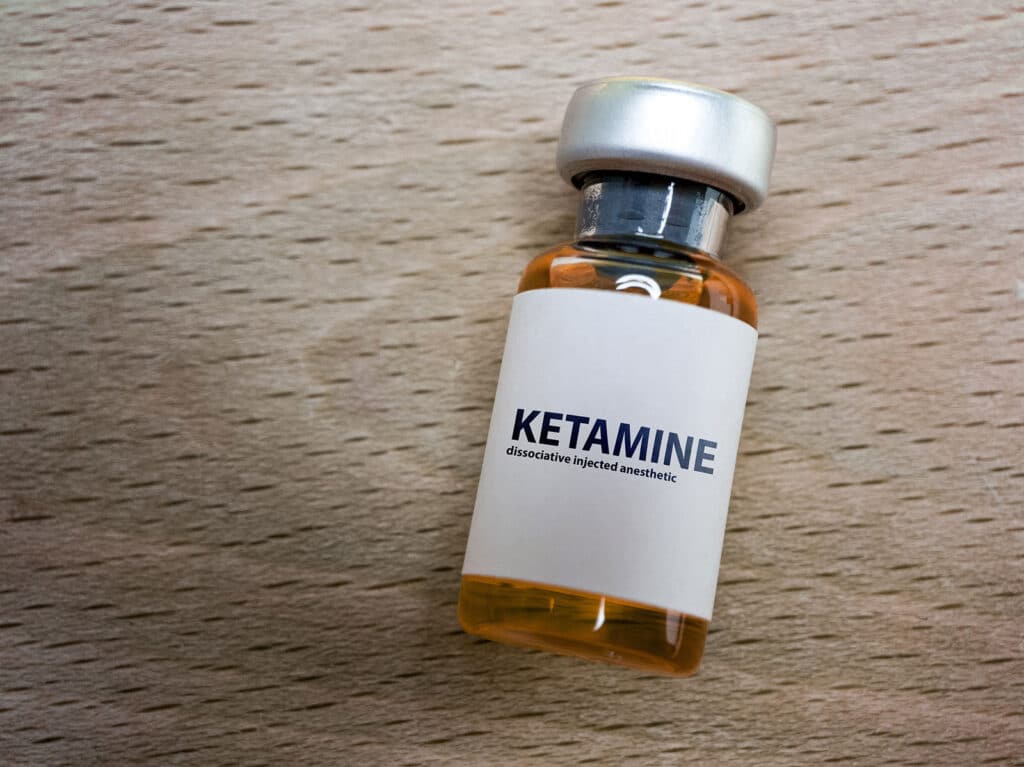Despite being relatively new, ketamine therapy for treatment-resistant depression is already gaining massive popularity. Back in 2015, there were around 60 ketamine clinics operating in the US. By early 2024, the number had jumped up to more than 1,000.
More and more people are trying to get their hands on an infusion or a nasal spray—so much so that the US ketamine clinics market is expected to reach $6.9 billion by 2030. That would be a growth of 10.63% CAGR from its 2023 valuation!
Can a new treatment option bring in that much money? How much is ketamine therapy on average?
Read on to find out the average prices for different ketamine products, the additional expenses, and the main risks to watch out for.

Table of Contents
- Spravato Sprays vs. Ketamine Infusions: Quick Overview
- Average Cost of Different Ketamine Therapy Options
- Extra Expenses to Consider Before Starting Ketamine Therapy
- 5 Reasons to Reconsider Ketamine Therapy
- Alternative Options for Treatment-Resistant Depression
- Before You Start Treatment: Final Thoughts on Ketamine Therapy
- Additional Resources
Spravato Sprays vs. Ketamine Infusions: Quick Overview
Before we get to the pricing details, we need to cover one caveat: ketamine isn’t approved by the FDA for the treatment of depression or any psychiatric disorder, for that matter.
So far, its sole approved use is as a dissociative anesthetic. In fact, the FDA has issued a warning against off-label use (more on that later) for psychiatric disorders.
Yet, a lot of clinics in the US still provide ketamine infusion for depression, OCD, PTSD, and other mental health issues. Some even use the drug as a treatment for chronic pain.
Things get even more complicated when you consider that there’s a slightly different option on the market.
We won’t dig deep into the scientific jargon, but you need to know that ketamine is actually a mixture of two enantiomers (a fancy name for molecules that are mirror images of each other). These molecules are called R-ketamine (arketamine) and S-ketamine (esketamine).
A vial of ketamine hydrochloride contains both enantiomers. However, esketamine alone is sold under the name Spravato, which is FDA-approved for treatment-resistant depression (TRD).
Here’s a quick comparison between the two treatments:
| Ketamine | Esketamine | |
| Brand Name | Ketalar | Spravato |
| Route of Administration | Intravenous (IV) infusion | Nasal spray |
| Use | Anesthetic (TRD off-label) | TRD (with oral antidepressant) |
| DEA Scheduling | Schedule III Controlled Substance | Schedule III Controlled Substance |
| Antidepressive Effect | Kicks in within 1 hour | Takes 2–4 hours to kick in |
| Typical TRD Treatment Plan | Six infusions, followed by boosters | Four-week induction, then maintenance doses |
| Requires Supervision | Yes | Yes |
| Insurance Coverage | Usually not covered | Might be covered |
Average Cost of Different Ketamine Therapy Options
Outpatient clinics that provide ketamine treatments typically operate on a fee-for-service arrangement. The facilities are run by healthcare providers who source the infusions/sprays and provide them on-site.
However, the prices can vary drastically from one clinic to another.
Here are some insights into the average cost for the different types of ketamine treatments:
IV Ketamine Infusions
A single ketamine infusion therapy can set you back $400 or more.
Some people report that each infusion in Boston costs $600. In other areas, ketamine clinics charge as much as $800 or even $1,000 per session!

Even at a $450–500 price point, the total cost of a six-infusion treatment plan can run as high as $4,500 when you factor in the pretreatment consultation and follow-up fees.
Note that some clinics set different prices for mental health patients and neuropathic pain patients.
It’s also worth noting that since ketamine infusion treatment isn’t even FDA-approved for mood disorders and mental health conditions, most insurance companies won’t cover the treatment costs.
So, that’s all money you’ve got to pay out of pocket.
Intranasal Ketamine Sprays
The typical esketamine treatment plan using drugs like Spravato calls for
- Weeks 1–4: Two doses per week for the induction month.
- Weeks 5–8: One maintenance dose per week.
- Weeks 9 and later: One maintenance dose every week or two, based on clinical judgment.
The induction month alone can easily cost you $4,800 or $6,800. The cost of the maintenance therapy, however, is somewhere around $1,200 to $3,600 per month.
That said, it’s possible to find an insurance plan that covers esketamine treatments. Get in touch with your insurance provider to check the details.
There’s also the Spravato withME support program. If you’re eligible, the medication costs could drop to $10. But, of course, there are maximum benefit limits for the savings program.
At-Home Ketamine Therapies
Not all ketamine therapies are done inside clinics. Some providers offer a sort of mail-order alternative that the patient then self-administers at home.
At-home therapies are often cheaper than IV infusions and nasal sprays offered at clinics. You could get enough medication for one session for less than $200. Some companies also pair their services with telehealth evaluations.
However, there are questions about the safety of at-home ketamine therapy.
With on-site nasal spray sessions, you have a medical professional there to monitor you for any side effects and negative reactions. That’s not guaranteed with at-home alternatives.
Plus, there’s the issue of taking more than the recommended dose, either accidentally or intentionally.

Extra Expenses to Consider Before Starting Ketamine Therapy
The session itself can be pretty pricey, but you might have to pay more for:
Other Prescribed Medications
TRD patients might need to take antidepressants along with the ketamine therapy. In fact, Spravato sprays are approved to be used only in conjunction with an oral antidepressant.
For reference, a 30-day supply of antidepressants can cost anywhere from $228 to $1,200+, depending on the type and dosing.
Psychotherapies
Medication (ketamine and/or antidepressants) alone might not cut it. The healthcare provider usually recommends sticking to some form of follow-up therapy session, and these aren’t particularly cheap, either.
In a clinic where the ketamine treatment costs $750, the therapy might be priced at around $250.
Boosters
Some people finish 6–8 sessions of ketamine therapy and don’t need to come back again.
Others notice that the symptoms start coming back after a while. In this case, they’ll need booster infusions, which can add up over time.
5 Reasons to Reconsider Ketamine Therapy
Even if you put the high price points aside, there are still concerns that can easily make ketamine therapy seem like a less-than-ideal choice.
Here are some things to consider before deciding if this treatment is the best option for you:
1. FDA Warning
In 2023, the FDA released a warning regarding ketamine products, including oral formulations.
The warning makes it clear that the FDA is aware that people are using compounded ketamine products for psychiatric disorders. The administration just doesn’t support these off-label uses.
After all, their safety and efficacy haven’t been evaluated yet.
2. Side Effects
There are a lot of side effects associated with ketamine use in general, including:
- High blood pressure
- Respiratory depression
- Bladder pain (and possibly incontinence)
- Stomach pain
- Problems with concentration and memory
- Disorientation and imbalance

3. Abuse Potential
Ketamine can be addictive. This is often a bigger concern with at-home therapies, where there’s no supervision.
4. Repeated Dosing and Effectiveness Drops
Another concern with ketamine therapy is that some patients will need larger doses over time. Otherwise, the treatment won’t be as effective.
As a result, the healthcare professional following up with the case might need to spread and taper treatments carefully.
5. Co-Existing Conditions
Finally, ketamine therapy isn’t for everyone. That’s not only because some patients don’t respond well to the treatment but also because the drug should be avoided altogether (or at least used with extreme caution) in some cases.
Take Spravato, for instance. It shouldn’t be used if the patient has certain health issues like aneurysmal vascular disease or a history of intracerebral hemorrhage.
Meanwhile, a patient with a history of psychosis or an active substance use disorder can be fully excluded from ketamine therapy.
Alternative Options for Treatment-Resistant Depression
When someone is diagnosed with TRD, their primary care provider might alter the medication strategy by switching antidepressants, changing doses, and so on. They’ll likely recommend psychotherapy if the patient isn’t seeing anyone as well.
So, ketamine and esketamine are hardly the first-choice therapies for depression.
What other options are there?
Aside from ketamine, the healthcare provider could resort to other treatment options like vagus nerve stimulation (VNS) and repetitive transcranial magnetic stimulation (rTMS).

Before You Start Treatment: Final Thoughts on Ketamine Therapy
There are still concerns with ketamine therapy in terms of FDA approvals, administration, and even pricing. The protocols could vary from one clinic to the next, and the prices fluctuate as well.
If you decide that the therapy is suitable for you, we recommend consulting your primary care provider before going in for your first infusion or treatment session.
Then, when you’re choosing a clinic, make sure to consider more than just the pricing. Don’t hesitate to ask about the success rate, treatment areas, follow-up therapies, evaluation strategies, and staff qualifications.
Hopefully, scientific research will keep providing us with safe, effective, and affordable treatments for conditions like treatment-resistant depression and PTSD.
Additional Resources
- DEA’s Ketamine Drug Fact Sheet
- Spravato (Esketamine) Patient Brochure
- Johns Hopkins Medicine: Next Steps for Treatment-Resistant Depression (TRD)
- A figure to visualize the difference between the two ketamine enantiomers



